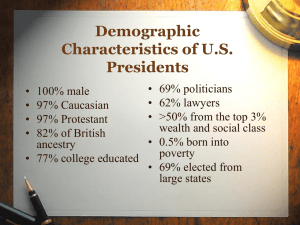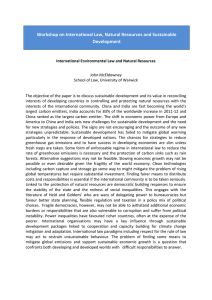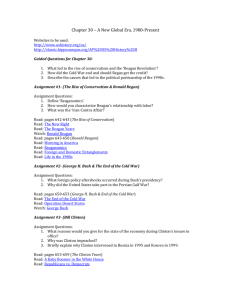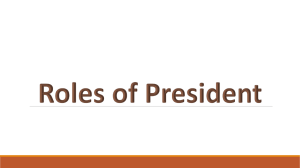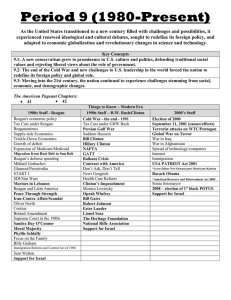THE WISDOM OF A CARBON TAX William G. Gale March 2016
advertisement
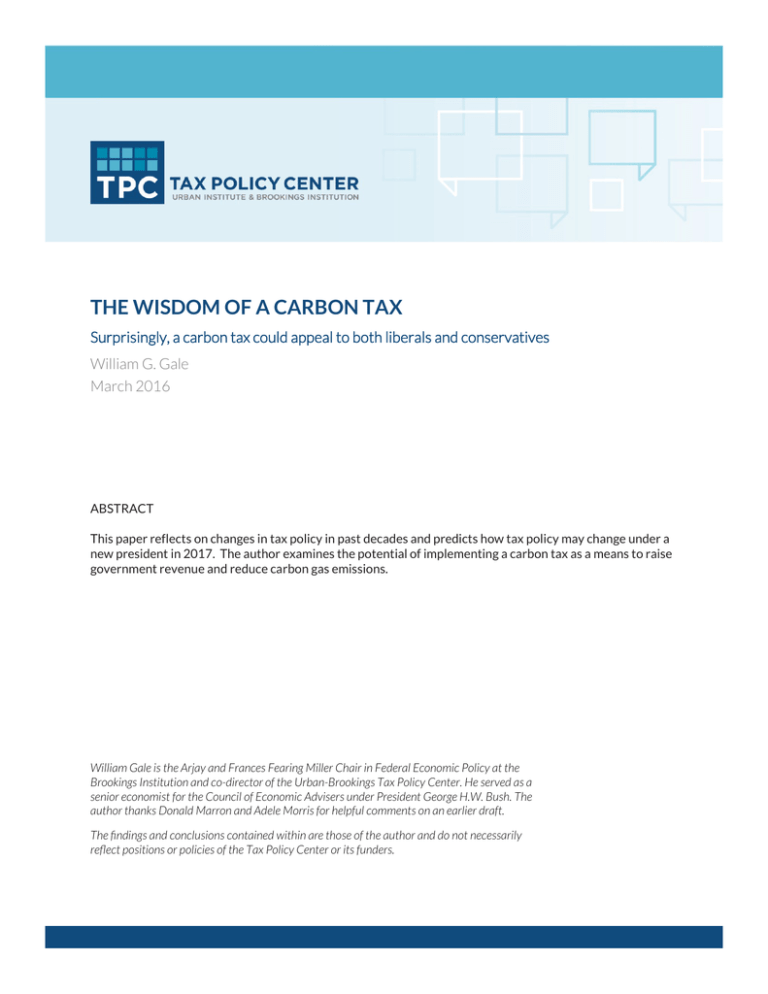
THE WISDOM OF A CARBON TAX Surprisingly, a carbon tax could appeal to both liberals and conservatives William G. Gale March 2016 ABSTRACT This paper reflects on changes in tax policy in past decades and predicts how tax policy may change under a new president in 2017. The author examines the potential of implementing a carbon tax as a means to raise government revenue and reduce carbon gas emissions. William Gale is the Arjay and Frances Fearing Miller Chair in Federal Economic Policy at the Brookings Institution and co-director of the Urban-Brookings Tax Policy Center. He served as a senior economist for the Council of Economic Advisers under President George H.W. Bush. The author thanks Donald Marron and Adele Morris for helpful comments on an earlier draft. The findings and conclusions contained within are those of the author and do not necessarily reflect positions or policies of the Tax Policy Center or its funders. Major tax policy changes have frequently occurred in a president’s first year in office. Ronald Reagan, Bill Clinton, and George W. Bush all achieved significant tax reform in their first years. While a president may ultimately have more than one bite at the tax apple, it is clear that a new chief executive gets a pretty big bite in the first year. Much determines exactly what and how much a president can accomplish. Perhaps the greatest two determinants are the party composition of each house of Congress and whether the president chooses to make tax reform a priority, particularly during the campaign. But regardless of party – and even of the makeup of Congress – the next president has an opportunity to do something truly dramatic: Implement a carbon tax. While this seems counterintuitive, given that most Republican candidates have not shown interest in the greenhouse gas policies often associated with a carbon tax, doing so makes good economic and political sense and has the support of a great number of economists, both liberal and conservative. A carbon tax would charge for carbon pollution, thus raising revenue, and allowing for a combination of long-term debt reduction and cuts to taxes on personal income and corporate profits. Tax Reform – Past and Present The first year of a new presidential administration has proven to be an auspicious time for changes in tax policy. Prospects are raised if the newly-elected president campaigned on a specific tax reform agenda or has the benefit of a unified Congress of his or her own party. But there is nothing automatic. Some presidents have not achieved or even pursued first-year reforms. Some tax changes have occurred after the first year, in the second term, or with a divided Congress. If the next president faces a Congress in which the opposition party holds one or both houses, it may be hard to see how major tax reform will occur in 2017. The political atmosphere seems too toxic to generate the good faith and trust needed to go into such discussions, or to generate the compromises needed to come out of such discussions with a significant reform proposal that could have majority support. If one party were to hold all of the reins of power, it seems more plausible, but still not necessarily likely, that a major reform could go through. Then again, looking back, previous presidents have implemented tax reform – and two of the most noteworthy examples did so even though they did not control both houses of Congress. Ronald Reagan, Bill Clinton, George W. Bush, and Barack Obama each pushed through major tax changes in his first year in office. For Reagan and Bush, the first-year tax reforms were TAX POLICY CENTER | URBAN INSTITUTE & BROOKINGS INSTITUTION 2 direct extensions or applications of their campaign platforms. Reagan campaigned on a proposal to cut taxes substantially. In 1981, he saw the Congress enact his tax measures, cutting the top personal income tax rate from 70 to 50 percent, creating a slew of saving and investment incentives, and indexing income tax brackets for inflation. Two decades later, George W. Bush made tax cuts a centerpiece of his campaign, and in 2001, Congress enacted his proposals virtually intact (and added a set retirement saving incentives). The new law provided immediate taxpayer rebates, cut income tax rates, created other subsidies, and cut estate taxes. The changes were phased in over time and all were originally scheduled to expire in 2010. For Clinton and Obama, the first-year story is a little more complex. After entering office, Clinton abandoned the middle-class tax cut proposal of his campaign and endorsed a deficitreduction package that raised taxes on high-income households. Obama campaigned under rapidly deteriorating economic circumstances as the financial crisis and Great Recession took hold in 2008. The landmark 2009 stimulus package was certainly related to, and consistent with, his campaign themes, but the details had to be ironed out after inauguration. Clinton and Obama were able to bring about tax changes with the benefit of a unified government, with the White House and both houses of Congress held by Democrats. Reagan and Bush faced divided Congresses, but were able to enact their tax programs anyway. Notably, none of the presidents in the four first-year examples above had to deal with a situation where both legislative chambers were controlled by the opposing political party. Of course, major tax policy can be enacted after a president’s first year. In response to the 1981 tax cuts’ effect on the budget, Reagan endorsed the major tax increases of 1982. The oncein-a-generation Tax Reform Act of 1986 occurred during Reagan’s second term and closed dozens of loopholes and cut tax rates, with the top rate falling to 28 percent – all in a revenueneutral and distributionally-neutral manner. The tax cuts in 1997 (the first year of President Clinton’s second term) were essentially a reward to both parties as the economy and budget improved after 15 years of grueling fiscal restraint and political compromise that followed the deficits generated by Reagan’s 1981 tax cuts and defense spending increases. In 2003, at President Bush’s urging, Congress – with Republican majorities in each house – accelerated the phase-ins from the 2001 legislation, provided new rebates, and cut tax rates on capital gains and dividends. The tax changes at the end of 2012 occurred at the end of the first Obama Administration. Still, it is remarkable how many major tax policy changes have occurred in a president’s first year in office. Looking Ahead A safe prediction is that there will continue to be complaints about the tax system, including in particular the personal and corporate income taxes. Still, to cut taxes for those areas without driving budget deficits deeper poses a problem. If the president wanted to alleviate the direct burden on earners – individual and corporate – he or she could offset the revenue loss by creating a carbon tax. The discovery and exploitation of natural resources by humans gave rise to the advanced civilization in which we live today. Coal, petroleum, and natural gas fueled industrialization, raising living standards and life expectancy for most. Energy use continues to fuel economic growth and development today. But along with the benefits of energy consumption come substantial societal costs—including those associated with air and water pollution, road congestion, and climate change. Many of these costs are not directly borne by the businesses and individuals that use fossil fuels, and are thus ignored when energy production and consumption choices are made. As a result, there is too much consumption and production of fossil fuels. Greenhouse gas emissions create a series of problems for the economy and the environment. The Intergovernmental Panel on Climate Change (2014) explains that emissions, if left unchecked, would increase “the likelihood of severe, pervasive, and irreversible impacts for people and ecosystems.” Economists have long recommended specific taxes on fossil-fuel energy sources as a way to address these problems. The basic rationale for a carbon tax is that it makes good economic sense: Unlike most taxes, carbon taxation can correct a market failure and make the economy more efficient. Greg Mankiw (2013), Harvard economist and former chair of the Council of Economic Advisers under George W. Bush, says that “among economists, the issue is largely a nobrainer.” To be clear, a “carbon tax” should address all greenhouse emissions to the extent that they are attributable to an identifiable party. Carbon dioxide accounts for the vast share of emissions in the United States, but other emissions of other gases – for example, methane and nitrous oxide – are more potent and would need to be taxed under separate schedules. Carbon taxes would contribute to a cleaner, healthier environment and better environmental and energy policy by providing price signals to those who pollute. Not surprisingly, most analyses find that a carbon tax could indeed significantly reduce emissions. Gilbert Metcalf of Tufts University estimates that a $15 per ton tax on CO2 emissions that rises over time would reduce greenhouse gas emissions by 14 percent, while Jenny Sumner, Lori Bird, and Hillary Smith of the National Renewable Energy Laboratory estimate that the European countries’ carbon taxes have had a significant effect on emissions reductions, attributing reductions of up to 15 percent to a carbon tax. Furthermore, the University of Ottawa found that the carbon tax implemented in British Columbia led to a 10 percent reduction in greenhouse gas emissions in the province, compared to less than 5 percent for the rest of Canada, where comprehensive carbon taxes were not applied. A carbon tax would also create better market incentives for energy conservation, the use of renewable energy sources, and the development of energy-efficient and low-carbon goods. The permanent change in price signals from enacting a carbon tax would stimulate new private sector research and innovation to develop new ways of harnessing renewable energy and energy-saving technologies. The implementation of a carbon tax also offers opportunities to reform and simplify other climate-related policies that affect the transportation sector. The tax would also reduce the U.S. economy’s dependence on foreign sources of energy, with potentially positive political connotations. A carbon tax could help the budget as well. A carbon tax set at $25 per metric ton on most greenhouse gas emissions measured in carbon dioxide equivalents (e.g. the amount of carbon dioxide that would result in an equivalent level of warming), growing 2 percentage points faster than inflation, could raise gross revenues equal to about 0.7 percent of GDP from 2016-2025 (around $160 billion per year), or net revenues of about 0.5 percent of GDP, after taking account of how other taxes would change, according to Tax Policy Center and Congressional Budget Office (CBO) estimates. For comparison purposes, note that CBO (2013) estimates that a $20 per ton carbon tax would increase the price of gasoline by about 20 cents per gallon. The revenue could be used to reduce other taxes and improve other economic incentives, bolster spending programs, or pay down the debt. Although a carbon tax would be a new policy for the U.S. government, such a tax has been implemented in several other countries. Thus, problems of administration can be handled by following the procedures used by other countries, piggybacking off of existing U.S. fuel taxes, or developing new options. There are several potential problems with a carbon tax, but each can be addressed. First, while it receives high marks on efficiency criteria when looking at the United States in isolation, a carbon tax could hurt the country if other nations do not adopt similar measures. Robert Stavins of Harvard notes that the largest efficiency gains would come in the form of internationally harmonized climate policies. While the United States is one of the largest per capita emitters of carbon dioxide, China is the largest overall emitter, and the European Union makes a significant contribution as well. Therefore, enacting a program that would lead to better cooperation with other countries and reduce emissions across the world would more effectively deal with the wellknown problems brought about by climate change, such as rising sea levels and higher frequency of extreme temperatures. In addition, there are ways to deal with competitiveness issues, including border carbon adjustments, the reduction of other regulations that could accompany a carbon tax, or lower corporate tax rates. Second, the tax can have a negative impact on low-income households that use most of their income for consumption. Nevertheless, this regressivity could be offset in a number of ways, including refundable income or payroll tax credits. The politics of the carbon tax are not easy. Conservative opposition to a climate-related tax, or any new tax, should not be understated. More than 160 members of Congress have signed the “No Climate Tax” pledge, opposing carbon tax increases that are not fully offset by other tax cuts. In addition, it would be necessary to provide adjustment assistance for communities and workers affected by the decline in coal consumption that would occur due to higher (aftercarbon-tax) prices of coal. There are precedents for this type of assistance, for example, with respect to the tobacco settlement, so it is a feasible proposition. Moreover, one should not underestimate how difficult it will be for a new president and Congress to thread the political needle, ingeniously bringing an end to an era of partisanship and gridlock. Still, there are rays of hope. The liberal case for a carbon tax is fairly straightforward and hinges on giving incentives to clean up the environment and address climate change. But there is also a conservative case, focusing on the role of public policy to provide insurance against adverse outcomes, to get market incentives right, and to obviate more costly approaches, such as regulations, subsidies, and mandates. The carbon tax could supplant at least some regulation of greenhouse gases under the Clean Air Act, which the EPA has begun to implement and which most conservatives oppose. Conservative leaders like George Shultz and Harvard economist Greg Mankiw have favored a carbon tax. John McCain proposed a cap-and-trade system, which can have similar economic effects to a carbon tax, more than a decade ago, and has spoken eloquently on the dangers of climate change. Some of the revenues from a carbon tax could be used to reduce corporate taxes, a proposal that may help garner conservative support. Conclusion The first year in office may well provide the best opportunity for the incoming president to influence tax policy. But history suggests that even a first-year program is not easy to enact unless the chief executive has campaigned on tax reform, and thus can claim a mandate on that issue, or has the benefit of having both houses of Congress held by his or her own party. There will continue to be disputes about the income and corporate tax well beyond 2017. In the meantime, the new president should seize the opportunity to lead the country to a carbon tax. The Tax Policy Center is a joint venture of the Urban Institute and Brookings Institution. For more information, visit taxpolicycenter.org or email info@taxpolicycenter.org Copyright © 2016. Urban Institute. Permission is granted for reproduction of this file, with attribution to the Urban-Brookings Tax Policy Center.
